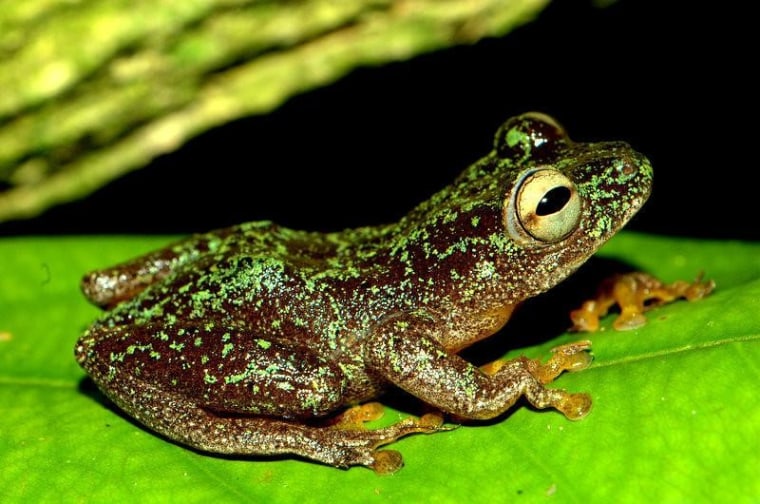In response to a call to seek out possibly extinct amphibian species, conservationists have rediscovered two frog species and one type of salamander that had been on the list of the missing. Conservation International and the IUCN Amphibian Specialist Group kicked off the search last month, and since then scientists have fanned out to look for scores of missing amphibians on the list. In a statement released today, Conservation International said the rediscovery of three species — decades after they went missing and were presumed extinct — serves as a "cause for celebration" as well as a reminder of the "shocking decline in the world's amphibian species in recent decades, with more than a third of all amphibians threatened with extinction." The endangered status of frogs, toads and salamanders is thought to be due to a variety of causes, including fungal infections, pollution, loss of habitat and climate change. Many of the species being sought make their homes in hard-to-get-to places, which adds to the difficulty of the quest. That's certainly the case for the three species that have been rediscovered:
N’Goran Kouame / Conservation International Hyperolius nimbae was rediscovered in Ivory Coast.
• Mount Nimba Reed Frog (Hyperolius nimbae), from Ivory Coast, was last seen in 1967. "Small and well-camouflaged brown frog rediscovered by local scientist N’Goran Kouame from the University of Abobo-Adjame." The find was made "in a swampy field in Danipleu, an Ivorian village near the Liberia border." • Omaniundu Reed Frog (Hyperolius sankuruensis), from Democratic Republic of Congo, was last seen in 1979. "Beautiful frog with bright green — almost fluorescent-looking — spots on a dark brown background. Rediscovered by Jos Kielgast from The Natural History Museum of Denmark." Here's more about Kielgast's hunt for the frog: "He discovered it while night searching areas of inundated primary forest along a tributary of the Congo River. He heard its call, and searched for the frog for over an hour. They are only active late in the night, and their call is short and infrequent. In the daytime they rest in an extremely cryptic color phase, making them nearly impossible to find. Initially Kielgast was led to believe that it was a new species by established experts but then later figured out that it was in fact H. sankuruensis."
Sean Rovito / Conservation International Chiropterotriton mosaueri was found in a Mexican cave.
• Cave Splayfoot Salamander (Chiropterotriton mousaueri) was found in Mexico's Hidalgo province. "Not seen since the discovery of a single individual in 1941. Pink-footed, brown salamander that is believed to live underground in cave systems. Several were found by scientist Sean Rovito from the Universidad Nacional Autonoma de Mexico, in a cave system which is only accessible by abseiling down a large pothole." Rovito's quest was arduous: "The locals took him to a cave, used as a source of water for the community. Just before sundown Rovito lowered himself into the cave with very low expectations of finding the species. Shortly after he spotted a large adult salamander with a long tail atop a rock on the cave floor. He knew it looked different from any other species he had seen." "These are fantastic finds and could have important implications for people as well as for amphibians." Conservation International's Robin Moore said in today's statement. "We don’t know whether study of these animals could provide new medicinal compounds — as other amphibians have, and at least one of these animals lives in an area that is important to protect as it provides drinking water to urban areas. But these rediscovered animals are the lucky ones — many other species we have been looking for have probably gone for good." Despite the odds, the search goes on, focusing on the world's top 10 "lost" amphibians. More rediscoveries are expected to be announced at the Convention on Biological Diversity, scheduled to take place next month in Nagoya, Japan. Check out the "Search for Lost Frogs" website for more about the quest — and while you're clicking around, browse through these archived reports about species lost and found:
- Amphibians wanted ... alive
- Deep-sea creatures of the Coral Sea
- The top 10 new species from 2009
- Beautiful biodiversity in Brazil
- New Guinea's 'Lost World' revisited
- Indonesia's 'Garden of Eden'
- Papua New Guinea's new species
- Marine marvels from Papua New Guinea
- Biological treasures from Borneo
- Celebrities of the Celebes Sea
- 12 froggy finds from India
- Fantastic frogs from Colombia
- Aliens lurk in Antarctic depths
- The strange species of Suriname
- Vulnerable new species in Brazil
- Discoveries from Vietnam's 'Green Corridor'
- Endangered species of the Mekong Delta
- New species from Australia's coral reefs
- Thousands of new species in ocean's depths
- Hundreds of new species amid the Himalayas
- New species found Down Under .. underground
- Eight 'extinct' species found alive and kicking
Join the Cosmic Log corps by signing up as my Facebook friend or hooking up on Twitter. And if you really want to be friendly, ask me about "The Case for Pluto."
